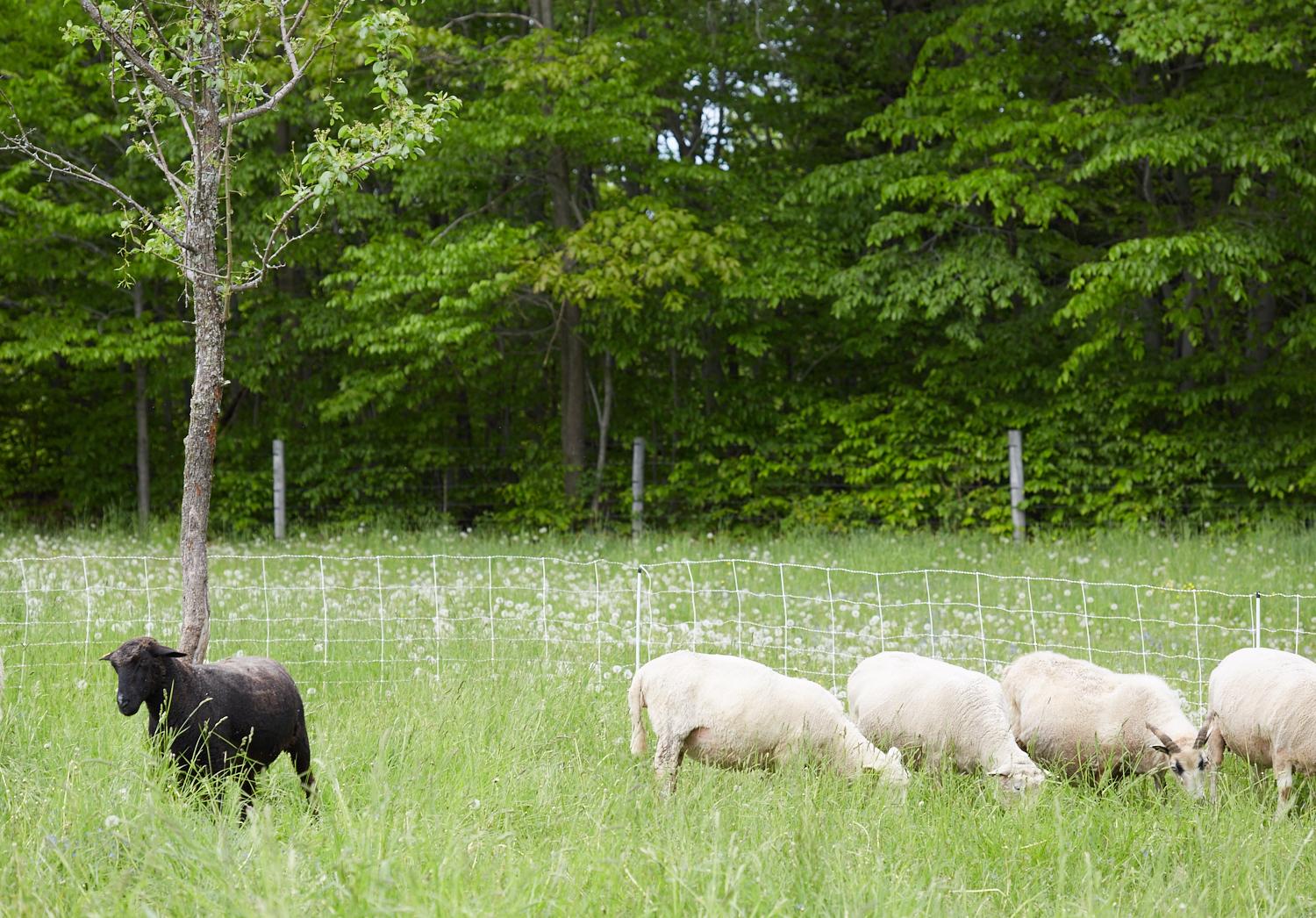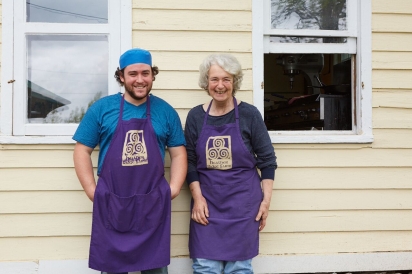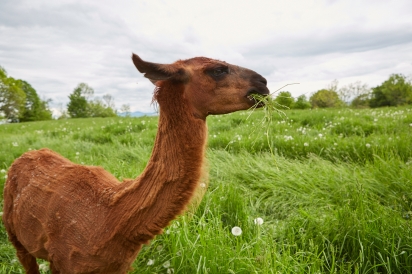Heather Ridge: Farm-Cafe-Social Club for Omnivores
After polishing off a platter of fresh-baked drop biscuits and Oink & Moo Chili, visitors can head back into Heather Ridge’s farm shop.
Pick up a plump little chicken for dinner later, grab a few gorgeous wedges of stinky artisanal cheese, a dozen freshly laid eggs, a quart of lard (pie!), fuzzy purple yarn for an afternoon of knitting; or why not some beeswax candles, honey, llama socks, that gorgeous landscape that was spotted in the dining room, a book by a local author. Load up the cart!
Then it’s time to wander over the fields and watch a llama flash a toothy grin, as yellow-eyed, shaggy Icelandic sheep baa in the grass and devilish goats curiously inspect the humans heading their way.
Donkeys are braying, chickens are cackling and scattering, geese are honking, an excited Australian shepherd is barking, guinea fowl are herding and bossing each other down the dusty farm lane.
Like a one-stop foodie, art, craft and family fun outfit dreamt up by Mary Poppins in eco-warrior mode, Heather Ridge Farm in Preston Hollow exists completely, deliciously apart from the ordinary. The roots of the farm tunnel deep down in the local soil. The sunny yellow farmhouse, the heart and hearth of the operation, was built in the 1820s. All of the food served on the menu at the seasonally driven weekend café and sold at the farm store comes from the farm or from other local farmers in the Catskills.
But the future is here. The farm is solar-powered, deriving its energy from pure sunlight. And the sources of inspiration for the innovative programs that founder Carol Clement and her core team— husband John Harrison, chef Rob Handel and farm manager Amanda Hughes—are various and far-flung.
“I built this farm because I wanted to create the best environment I could for the animals, the best food for our customers and be the best stewards of our land,” Carol explains. “But I also set it up as a big, public social project because I wanted to serve the community and also draw people here. Chef Rob and I both grew up in the Catskills as resort brats. Our parents owned hotels so serving others is a big part of who we are. It’s a joy.”
Growing up between Saugerties and Woodstock, Carol would look up at Overlook Mountain and say, “I’m going to live on top of that mountain one day,” she recalls.
Carol does live on top of a mountain, just not Overlook. And her journey to Scott Patent Mountain was anything but direct.
“I went away to school and lived in Los Angeles and New York City for many years,” Carol says. But the mountains beckoned. And in 1979, she heeded their call—tentatively, at first.
She bought a home on the land next to what is now Heather Ridge and started small. “I was a homesteader from the start,” Carol says. “I raised pigs and sheep and kept bees. At that point, I was just learning. I wasn’t buying specific breeds, I’d just take spare pigs and sheep o of neighbors hands.”
Carol worked in marketing, developing a network of contacts with nonprofits in the area, like the Catskills Center for Conservation and Development, which had received a grant to help struggling dairies in the 1980s. It was a dark time for farmers in the Catskills.
Gazing around at the cozy 20-seat dining room of her farmhouse— a mixture of rectangular and round wooden farmhouse tables, benches and delightfully mismatching chairs, decorated with gorgeous landscape paintings by local artists and photographs of animals cavorting on her farm—as the scent of sizzling pork sausage on the grill hovers in the air and the buzz of happily chatting Sunday brunchers bounces like a bright-red ball past our table, just within reach, it’s clear Carol’s mind is elsewhere. She looks quiet, pensive.
“The backbone of this region was dairy farmers,” Carol says slowly. “And the price of milk was plummeting. The future was uncertain and real estate values here were way down. Small farmers were barely hanging on, and then the government started buying out these dairies, shipping the cows out to bigger outfits in the Midwest. Everyone was going belly up. Some farmers hanged themselves in their barns, it was truly terrible.”
The Catskills Center received a privately funded grant to help the farmers that were left to survive. The organization hired Carol to help in outreach and planning, and as her familiarity with the local producers increased, her commitment to the future of the small American farm strengthened and her roots in the community deepened, an opportunity presented itself to not only help others fight the good fight but actually join the struggle itself.
Her face clears. The sad, gray glimmer in her eye is replaced with one of flinty determination and just a hint of delighted hope.
“The elderly couple who ran the dairy farm next door to me passed away, and in 1990 I decided to buy it,” Carol says. And so a journey began. Slow, but steady. In 1999 she married John, and when he retired from his job with Verizon in Albany, he joined her to help run the farm full-time.
Carol and John have grown the farm together holistically, bringing in new animals and offerings only when those pieces can cooperate symbiotically with the structure already in place.
Carol and John have grown the farm together holistically, bringing in new animals and o erings only when those pieces can cooperate symbiotically with the structure already in place.
The Farm
The farm, naturally, comes first, and their system of managing it is both ancient and highly entrepreneurial.
“We don’t own a tractor,” Carol tells me, herding my four-year-old twins into the goat and llama field to hang with the animals. “Oh they’re fine,” she says, catching my husband and me exchanging pained expressions as Emily attempts to mount a goat named Cleopatra and Miles runs shrieking after a surprised and horrified hen who popped over to see the visitors.
It takes a special type of grace to personally and tranquilly manage such a complex, sprawling operation without machinery, but she and John wouldn’t have it any other way. On their 160 acres of fields, they practice intensive managed grazing, constantly moving the animals to fresh grass. This method allows all of the fields they pick clean and then pepper with poop to properly compost and renew, no machines and the diesel fumes that come with them to worry about.
Studies show that a grass diet and constant exercise also ensures a more lean and flavorful meat, with higher levels of omega-3s and CLAs when compared to conventionally raised corn-fed meat.
All told, Heather Ridge hosts about 36 breeding Icelandic ewes, 2 rams, 25 Boer (for meat), Nubian and Saanen (for dairy) goats, 7 llamas, 4 alpacas, 100 laying hens, 9 geese, 18 to 36 pigs (only in the spring and summer), 10 cattle (only in the spring and summer), varying numbers of turkeys, ducks, guinea fowl and bees, plus 3 donkeys.
The llamas may seem like little more than hipster eye candy, but Carol assures me they are essential.
“They are our guards,” she says. “They scare off the coyotes and dogs, and thanks to them, we haven’t had any problems with predators.”
It’s clear from the way John and Carol pet and cluck over the animals, many of whom have names (and some of which cannot be reprinted), and the way the animals eagerly trot over to the couple and interact congenially, even with misbehaving preschoolers, that they are as well-cared for as any animal destined for the dinner plate could be.
Some of the animals on the farm have even become minor celebrities in Albany. “We have a contract with Albany so eight of our goats go each year to the Loudonville Reservoir to eat the overgrowth of grapevines, sumac and bittersweet that man and machine can’t access on the hilly terrain. Without their help, woodchucks and water birds nest in the overgrowth, leaving waste that pollutes the 212 million gallons of drinking water destined for the region’s taps below.”
Bees Knees Café
Carol opened the Bees Knees Café eight years ago, ushering in a true farm-to-table bastion in the Catskills. Part of her motivation was sim- ply to bring outsiders in: “I don’t get out much, so I have to bring the party here,” she laughs. But, drawing from her broad background knowledge of the basic structural challenges regional farmers are struggling with, Carol saw the Bees Knees as a way to help pad out the supply and demand chain in the Catskills.
“One of the reasons responsibly grown food has started costing so much is because we don’t have enough infrastructure here to support family farms,” she says. “We need more cafés, more people interested in buying from small farms, more slaughterhouses. Without an infrastructure, there’s no way to compete on price with big outfits from out in the Midwest.”
When running a farm and operating a growing café (open on the weekends for brunch year round and ursday through Sunday in the summer) got to be a bit much, she brought chef Rob Handel to man the grill three years ago.
“He did so much more than just cook,” Carol says. “He had a real vision. He came to me with an idea for a supper club, and I let him run with it. Rob has structured the menu so we only need to get a few items from afar, like lemons and co ee.”
Eating and cooking local is in Rob’s blood. “I learned how to cook from my Grandma,” he explains. “She would take me foraging with her, and as I got a bit older, I started really researching. I got into the Foxfire book series and learned about traditional regional methods of preserving and fermenting foods, using wild game, cooking with wild herbs, nuts, seeds and berries.”
Rob’s supper clubs have become epic five-course sell-out events held monthly. They feature exotically executed farm-fresh meat and dairy, items foraged from the elds and forests, and produce from farm friends just about a holler away. (Think: boudin blanc, spice-bush-scented duck breast prosciutto, duck confit rillettes, foraged mustard, pickled fiddleheads, vin de noix aspic, amazake rye bread. And that’s just one course).
A favorite and blessedly portable Rob creation is his handmade root beer. His inspiration hails not from the fuzzy stuff you try to hide from your kids but from the tincture made from local roots and herbs favored by Native Americans centuries ago. (Charles Hire is credited with introducing it to the rest of us in 1893.)
“I was out foraging on the farm one day, and I stumbled on a grove of black birch trees that I’d never seen before,” Rob recalls. “I picked some twigs and started experimenting with other foraged herbs.” He studied recipes that Hire left behind, tweaked them, bounced ideas o of his circle of fellow foraging friends on Facebook.
Now, he creates 108 bottle batches of concentrated syrup at the farm and sells it at the farm store and to bars and restaurants like New World Bistro, the R&R Taproom and the Farmers’ Museum.
Community Events
Part and parcel of Carol’s vision is helping to lift up new and old farmers by collaborating, selling each other’s products and teaching each other skills.
In the early spring, she runs lambing and kidding workshops to teach ambitious 4-H’ers, the curious and those considering a career change, how to breed lambs, ensure a healthy gestation, support the animals during the birthing process and care for the newborn kids.
“We love sharing our techniques and knowledge with new farm- ers,” Carol says. “If we want to change the food system, we have to start with ourselves.”
Starting this summer, Carol will also be renting out two farm cottages built in the 1940s for farm getaways. In addition to the amenities right outside the door, the fridge will be packed with farm-fresh milk, eggs and bacon, plus cooked lunches and dinner at the café and Supper Club.
It’s still an uphill battle. But with people like Carol opening her heart, hearth and home to other farmers, curious eaters and irrepressible goat-loving kids, it’s hard to imagine the Capital Region will be leasing out farmland to developers and sending its animals anywhere anytime soon ... except maybe Albany.
Those weeds won’t cut themselves.













